Blog by Morgan Pinkerton and Tina McIntyre, UF/IFAS Extension Seminole County
What are some commonly encountered invasive weeds in rural areas and what should I know about them?
In rural areas, invasive species can run rampant. Often, rural areas go unmanaged for longer periods of time than urban areas. For this reason, the invasive species can get out of control, before someone even realizes they are a problem. Below you will find some invasive plants commonly found in rural areas. Click the plant names to find out more information on each species.
Air potato, Dioscorea bulbifera

From backyards to natural areas, air potato is widespread throughout Florida. Air potato was introduced to Florida from Africa in the early 1900’s, but it has been one of Florida’s worst invasive species since the 1990’s. This plant can grow very quickly, up to 8 inches in a single day. In unmanaged areas, air potato can completely take over, even climbing and covering large trees. It can reproduce by bulbils, or aerial tubers, that look kind of like potatoes. Even if you remove all the foliage, the plant can grow back from the remaining bulbils. In Florida, there is ongoing release of the air potato leaf beetle, Lilioceris cheni, for biological control of the invasive plant since 2012. The beetle eats the leaves of the plant. Over time and in combination with hand removal, the beetle can help reduce the amount of air potato in an area.
Australian Pine, Casuarina equisetifolia
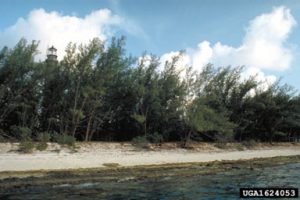
Introduced in the 1800’s as a salt tolerant tree, the Australian pine grows very tall. Although the name suggests otherwise, they are not actually pine trees, but rather a flowering tree. The Australian pine has spread to many natural areas, smothering low lying native plants with fallen needles. Near coast lines, the pines have covered areas that were once nesting sites for native aquatic wildlife. These trees are often prone to falling over during severe wind, such as in a hurricane. If you have this species on your properly, consider removing it so that it cannot spread seeds into unmanaged natural areas.
Brazilian Peppertree, Schinus terebinthifolia
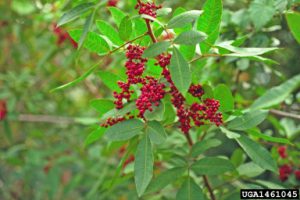
Brazilian peppertree can be a shrub or grow into a large tree. It is a very aggressive plant that has spread across the state of Florida. The dense plant canopy can shade out other native plants and further disrupt the native ecosystems. Plants will flower typically between September and November with fruit mature appearing around the end of the year. The fruit are red when they are ripe. The sale and movement of Brazilian peppertree is prohibited in Florida. Current management research is investigating the use of insects as biological control agents for this species. Not all bad, this invasive plant can provide flowers for beekeepers and their honeybee hives during the time of the year when plants are not flowering.
Caesar weed, Urena lobata

This invasive species is in the same plant family as hibiscus and cotton. Caesar weed can start out small but can grow to be a shrub as tall as 10ft! It is very fast growing and can reach up to 7ft within the first year. This species invades many environments from hardwood hammocks to farms and pastures. The leaves are palmately lobed and the plant can look pretty fuzzy. They can also produce pink to violet flowers that are about 1cm across. Seeds can stick to clothing and other surfaces so watch out for the hitchhiking seeds. It is persistent in shady and full sun environments, which makes it difficult to eradicate.
Cogongrass, Imperata cylindrica
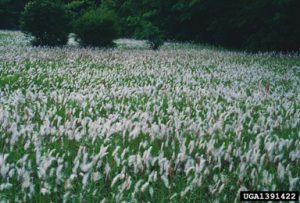
Cogongrass is an aggressive perennial grass found throughout the tropical and subtropical areas of the world. It was introduced to Florida as a potential forage crop in the 1930-40’s, but problems with this species soon followed. Thriving in sandy soils, cogongrass grows in pastures, natural areas, roadsides and more. It is a large grass often identified by a distinctly off-centered, white midrib on the leaves. Seeds form on what looks like a fluffy off-white plume. The leaves are serrated which is one reason why it is not a good forage crop for cattle. Cogongrass is difficult to control because the plants have rhizomes that also help it spread vegetatively. Over half of the plant is actually below ground in the rhizome root system! In many cases, herbicides are used for control of cogongrass in rural areas.
Coral ardisia, Ardisia crenata

Introduced as an ornamental plant, Coral ardisia escaped cultivation in the 1980’s and is now established in many natural areas of Florida. It is a small, upright shrub that was once sold under the name Christmas berry. This invasive plant shades out native plants, thus disrupting the local flora and fauna. Like seen with Brazilian peppertree, Coral ardisia also produce red berries that turn coral red when ripe. Birds readily eat the berries and defecate seeds into new areas. This plant is toxic to livestock, pets and humans. Existing plants should be removed, before seeds are produced. If the plant already has fruit, be careful to also collect any berries that fall during the removal. Some native plants that are great alternatives for landscape or natural areas are marlberry (Ardisia escallonioides), wild coffee (Psychotria nervosa) and myrsine (Rapanea punctata).
Melaleuca, Melaleuca quinquenervia

Melaleuca, also known as the paper bark tree, is native to Australia. In Florida, the trees can grow into immense forests and are particularly a problem in and around the Florida Everglades. Prior to the introduction of this invasive tree, the Everglades were mostly a “river of grass” dotted with an occasional Pond Apple tree. Now, melaleuca trees are found throughout the everglades, severely disrupting this unique ecosystem. These invasive trees can grow to be 80ft tall. The bark is whitish and peels away in layers, almost like paper. It produces a huge number of seeds on short, cylindrical woody fruit. There is ongoing research on biological control agents to help control melaleuca in the Florida Everglades.
Monkey Ear Tree, Enterolobium cyclocarpum
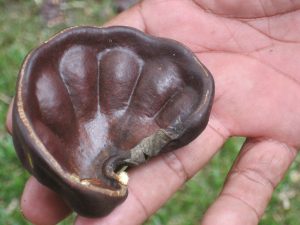
This species gets its name for the semicircular seed pod that resembles a monkey’s ear. It is an introduced species, identified by local experts as a potential invasive species. Monkey ear tree survives well in warm, moist climates like Florida. Trees can reach heights of 75ft. The leaves are oblong and have an alternate arrangement that is bipinnately compound. In recent years, this plant is becoming more common in rural areas suggesting it could become an invasive species. It is also an opportunistic species, taking root in both dry and wet areas.
Natal grass, Melinis repens
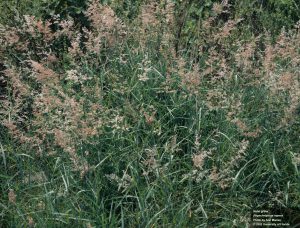
Natal grass is an annual grass native to South Africa. It was first introduced to Florida as a forage crop but lacked nutritional qualities ideal for cattle. It primarily spreads by seed which can easily be carried by wind; however, it also reseeds following fires. Natal grass will displace native vegetation and can often found in unmanaged fields and pastures. Mowing does not provide control. Plant removal and herbicides are currently the only known management strategies.
Paragrass, Urochloa mutica
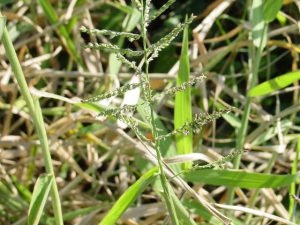
This invasive species was brought to the US from Africa as a forage grass. In areas where there are not cattle to graze, Paragrass is a serious problem. It can survive in both drought conditions and flooding and has displaced many native species in Florida’s swamps and marshes. The plant also can produce a chemical that inhibits the growth of other plants. Although this is a cool reproductive strategy for the plant, it contributes to its invasive behavior. Additionally, the invasive plant can form floating mats that impede water flow in ditches and canals. Burning, tillage and chemical control can all be used to combat Paragrass in areas that are not grazed by cattle.
Torpedo grass, Panicum repens
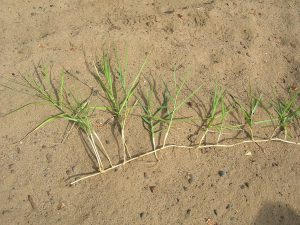
From lawns to farms to natural areas, torpedo grass is a problematic invasive weed throughout Florida. This invasive weed displaces native vegetations near shallow water. It also can invade landscape turf and agricultural fields. Similar to many rural invasive weeds, torpedo grass was introduced to the US as a forage crop and later became an issue. It gets its name from the sharply pointed growing tips. The management cost of torpedo grass in Florida’s waterways is over $2 million annually. In Florida, the spread is mainly by rhizomes. If you attempt to remove this invasive plant and do not remove all of the rhizomes, it can reestablish. Chemical control is often used in management.
Interested in participating in Weed Wrangle© Week 2021?
Check out this article for more information on what is going on locally this week. Be sure to catch all the other cool resources we are sharing this week on our Central Florida CISMA Facebook page!
More Resources
- Central Florida Cooperative Invasive Species Management Area
- Florida Invasive Species Partnership
- Florida First Detector Program
- Invasive Weeds EDIS Documents
- UF Center for Aquatic and Invasive Plants
- WeedWrangle.org
 0
0
